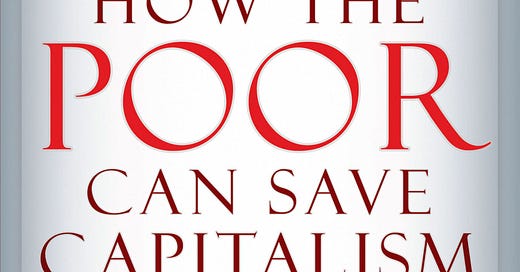Book Review: “How the Poor Can Save Capitalism: Rebuilding the Path to the Middle Class,” by John Hope Bryant, San Francisco, CA: Berrett-Koehler, 2014.
There are many theories about how people become poor. There are even more theories about how they remain that way.
Some people automatically think of the “American city” as the center of poverty, some thinking it is the city itself that causes the poor, causes the despair, causes grief, and causes doom.
John Hope Bryant disagrees.
He feels it is up to the poor to fight the city. He is an entrepreneur, visionary, business man, and facilitator. He proposes saving America by saving its cities. His inspiration is his understanding of the hopes of Reverend Martin Luther King, Jr. His message is based on what he has seen in big cities and on the mentoring he has received from Ambassador Andrew Young, former Mayor of Atlanta.
In this short text, the author explains his reasons for wanting to help the poor, explains how the poor do not understand capitalism, and shows the importance of investing in education as the principle way to help. Bryant shows a firm understanding of how to bridge different worlds.
Teaching fiscal literacy and responsibility is at the core of what Bryant is doing to help the poor climb toward the Middle Class – or back to it.
Bryant tells of several interesting strategies that can be used to reach the poor, educate them on important information they need to succeed, and move up into financial security. He has already had some success in the schools with his financial literacy education programs. He has organized his efforts so they can have broader appeal and use nationwide as he works to help those in poverty.
He has two main ways to solve the financial issues of the poor. The first is the HOPE Plan which includes several key components. One is establishing federally-funded financial literacy education for every child in the nation. In the long run, this can pay off. Another important investment to make is transforming non-violent prisoners into informed citizens, rather than just housing them and then releasing them. Another investment is improving the credit score of entire communities in an effort to get everyone on board. These things cost money, true, but Bryant has already had some success with some of the components of this plan.
The second way is through Project 5117, a four-pronged approach to fighting economic inequality. One piece has to do with empowering five million young people with financial literacy; another is to help one million of them to become entrepreneurs in their home communities. Another piece is establishing one thousand “bottom up” banks to help the poor borrow and invest. The last piece is to increase credit scores of some citizens to the rate of 700. He has clear ideas how to achieve these goals, and he has already begun work on them.
Bryant hopes for a new generation of educated, empowered, inspired young people, who are informed homeowners and contributing business owners. He has already gotten the support of some strong allies in the political and entertainment worlds.
It is important to consider Bryant’s ideas and plans as we educators, advocates, and activists look to ways to help society. Helping the poor is an honorable and purposeful endeavor. And as Bryant shows, it is a good investment.
I recommend this book wholeheartedly because I feel strongly we need some good rigorous models for assisting the poor, helping them to participate in the dialogue, and helping them to contribute to society.
While these may seem like rather basic activities, they are indeed the kinds of work the poor could embrace, given enough support from activists, advocates, industry, and the government.




